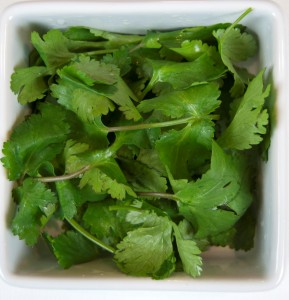
Cilantro is a leafy green herb that resembles the Italian or flat-leaf parsley and comes from the coriander plant. This green herb has a distinct taste depending on those who can taste all its flavor compounds. For those that cannot, cilantro can taste metallic or soapy. For those that can taste its flavor compounds, cilantro has a bright, pleasing taste that livens up any dish. Cilantro has been very popular in Mexican, Indian, and South American cuisine, but it is relatively new to North America. Although cilantro is not one of the primary herbs used in the United States, it is very popular among Peruvian dishes and every Peruvian keeps fresh cilantro in the refrigerator.
Cilantro has an array of uses from garnishes to dishes. This herb is often used as the base for a dish, while the rest of the ingredients are built around its unique flavor. These dishes can include soups, stews, or even juanes. Cilantro can also be used as the centerpiece for sauces and dips.
With antioxidant, antifungal, and antibacterial properties, cilantro is phytonutrient dense and considered to be a powerful herb. It can support heart health and has anti-diabetic activity, but can also be a sleeping aid. Studies have shown that cilantro supports cellular health and body fluids that help control heart rate and blood pressure. This herb has a protective effect on the cells of the heart, helping to prevent heart attacks and oxidative damage. The leaves and stems are rich in numerous antioxidant flavonoids that scavenge free radicals and helps prevent the onset of heart disease and cancer. In addition, research proves that the stems and leaves of cilantro may also be helpful for diabetes management. Cilantro has also been shown to regulate blood glucose levels by lowering blood sugar. Furthermore, cilantro has been shown to support red blood cell production due to its iron content.





